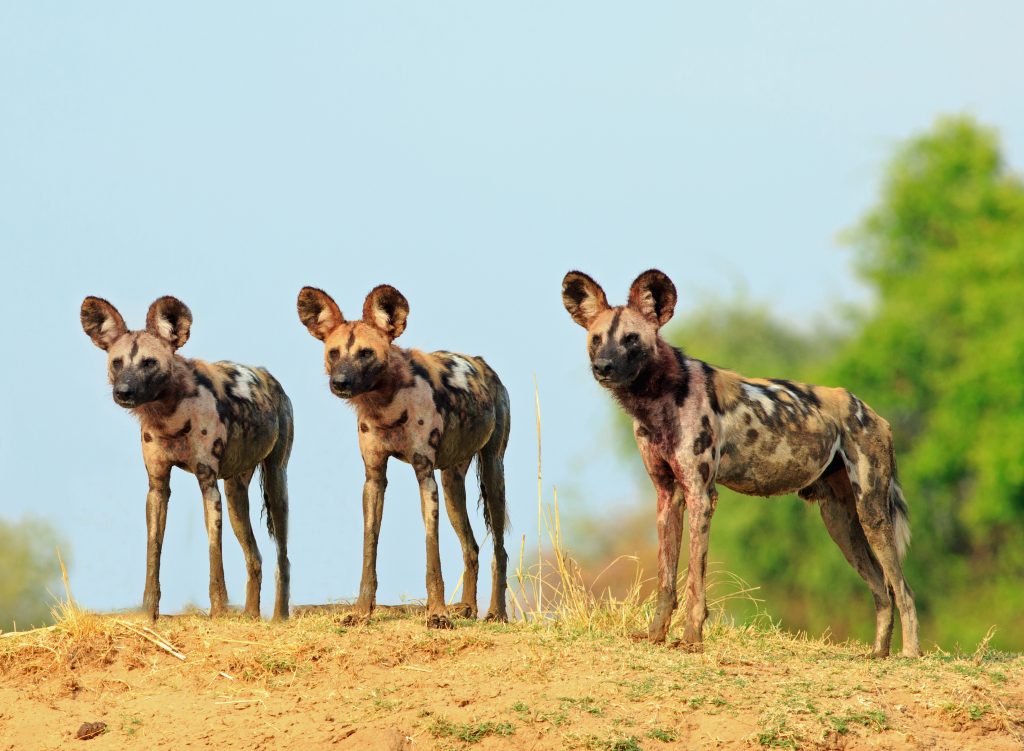
African Wild Dog vs. Hyena, Know the Difference!
African wild dogs and hyenas are two groups of animals that have inhabited Africa for hundreds of thousands of years. While these two animals may look somewhat similar, they are drastically different with divergent evolutionary histories. Today, let’s take a moment to better understand the differences between African wild dogs and hyenas.

African Wild Dog
This canine, also known as the painted dog or Cape hunting dog, is known scientifically as Lycaon pictus. The African wild dog is the only species still living within its genus, Lycaon. Let’s take a closer look at L. pictus so that we can compare it to the hyena.
Morphology
The African wild dog is the largest of the African canines. It stands 60 to 75 cm (24 to 30 in) tall at the shoulder and weighs upwards of 37 kg (80 lbs). Fur color is extremely variant within African wild dog populations. Their colors can range from almost entirely black to almost entirely grayish-yellow.
Distribution
The International Union for Conservation of Nature (IUCN) lists the African wild dog as “endangered – population decreasing.” The IUCN breaks the historical and present populations up into geographical regions.
- Northern Africa: Historically, L. pictus thrived in northern Africa. Hunting, trapping, and poisoning have killed off the vast majority of the population. The current population size is unknown.
- West Africa: Like northern Africa, the African wild dog is all but extinct in West Africa. The largest population exists in Niokolo-Koba National Park in Senegal. The most recent population data (1997) suggested that 50-100 individuals were still living in the park.
- Central Africa: The healthiest population exists in 3-4 small packs in the country of Chad. Hunting has been particularly detrimental to the dogs in Central Africa.
- East Africa: This region presents the best opportunity for wild dog population growth. L. pictus is a protected species in Tanzania, and Ruaha National Park likely has the largest population of the canine in Africa.
- South Africa: Similar to eastern Africa, biologists hope that South Africa can serve as a haven for the wild dogs. They enjoy a less protective status across most of the region, yet some of the largest populations occur here.
Habitat
The African wild dog prefers open savannas and semi-arid plains. They generally avoid fostered areas, likely due to their hunting preferences. They require a long, unobstructed line of sight to chase down prey.
Behavior
Like most canines, African wild dogs are extremely social animals. They live in packs with sizes ranging from several to over two dozen individuals. The wild dogs have a rather odd social hierarchy and pack structure. The males tend to stay with the pack, while the females disperse after mating. This means that males often outnumber females 3:1.

Hyena
In contrast to the African wild dog, hyenas are not all the same species. Rather, the term applies to any member of the family Hyaenidae. For comparison, African wild dogs are true canines because they belong to the family Canidae. Conversely, hyenas are not dogs.
Morphology
There are four species of hyenas: the aardwolf, spotted hyena, brown hyena, and the striped hyena. Their coats are extremely variant. Some species have spots, other stripes, others yet are a single solid color. They are united by their build, though. Hyenas have characteristically short hind legs and long front legs. This makes them appear to “slant” upwards towards the snout when standing. The largest species can grow to a shoulder height of roughly 36 inches and weigh up to 150 pounds.
Distribution
The spotted hyena and aardwolf are listed by the IUCN as “least concern.” Similarly, the brown and striped hyenas are listed as “near threatened.” Collectively, their extant range covers the entirety of the continent of Africa as well as large parts of the Middle East. Individually, they cover different parts of this vast region.
- Brown Hyena: This is the strictly southerly species of hyena. Its current range includes Namibia, Zimbabwe, Botswana, Mozambique, and South Africa.
- Aardwolf: This hyena has a southern distribution similar to the brown hyena. Additionally, it also resides in the Horn of Africa in present-day Somalia, Ethiopia, and Kenya.
- Spotted Hyena: This species has a very large range. It is bounded on the north side by the Sahara Desert, and on the south side by the warm, wet, Mediterranean climate of southern South Africa. Notably, these hyenas are not usually found in the Democratic Republic of the Congo, the Republic of Congo, Gabon, or Equitorial Guinea. These areas generally contain forests that are too dense for hunting.
- Striped Hyena: This hyena has the most northern distribution. It generally lives north of the Sahara desert along the Mediterranean. Additionally, it is also found on the Horn of Africa, like the Aardwolf.
Habitat
Generally speaking, hyenas occupy the same type of habitats as African wild dogs. They prefer to live on wide-open plains, savannas, and grasslands. They are different than the wild dogs, though, in that hyenas also tend to occupy much more arid desert land as well as semi-mountainous terrain.
Behavior
- Brown Hyena: Their social structure is analogous to that of wolves. They tend to live in mating pairs and with offspring, when applicable. Occasionally, brown hyenas will live in “clans” of up to six adults. All mature individuals share cub-rearing responsibilities.
- Aardwolf: This species of hyena is uncharacteristically shy. They live in monogamous mating pairs and typically feed at night.
- Striped Hyena: This hyena is similar to the aardwolf in that it typically lives alone or in a single mating pair. Also similarly, the striped hyena is almost entirely nocturnal.
- Spotted Hyena: Spotted hyenas have a drastically different social structure. They live in “clans,” like brown hyenas. Unlike brown hyenas, spotted hyenas almost always live in these clans, and they can have up to 80 members.

Wild Dogs vs. Hyenas
Now that we’ve had an in-depth look at both African wild dogs and hyenas, let’s sum up some of the major differences between them.
- Size: The smallest hyenas are slightly smaller than African wild dogs (~24 inches), while the largest (~36 inches) are considerably bigger.
- Mass: The largest African wild dogs (~80 lbs) weigh about half as much as the largest hyenas (150 lbs)
- Evolution: African wild dogs are exactly that – dogs. They are closely related to wolves and other canines. Hyenas are not canines and are more closely related to the mongoose.
- Social structure: African wild dogs are very social, group-oriented animals. With the exception of spotted hyenas, all other hyenas are rather shy and solitary.
- Conservation: Hyenas enjoy a comfortable, not-endangered status. In comparison to the African wild dog, their habitat, territory, and population sizes are much more intact and healthy.
Check us out on EarthSnap, a free app brought to you by Eric Ralls and Earth.com.
News coming your way












